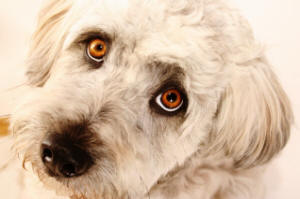 Why
dogs act out
Why
dogs act out
To prevent
these common dog behavior complaints as well as house soiling and hyperactivity, you must
consider two important factors.
One, canines are a different species but do have some of the same basic needs that
humans do. Your dog needs a certain amount exercise, companionship, and mental stimulation every day. It is cruel to keep a dog cooped up in a back yard.
Second, you must think from the dog's point of view. How
can you motivate your dog (and help your dog how) to learn a basic human vocabulary such as come, sit, down, stay, wait, inside, outside, move, easy, quiet, off, etc.
Unfortunately, dogs today share the same stresses and problems as their
human families. It's typical these days for dogs be home alone all day
while their people are working. When their people come home, they may not have
the motivation to exercise the dog, provide valued and needed companionship,
interactive play and instruction as part of important dog-human communication.
What is dog stress?
Signs of stress include any new
behavior such as hiding, cowering,
shaking, tail tucked, inappropriate
elimination, abnormal destruction,
not eating, not greeting you, eve lack
of coat luster.
What
t
o do
about it?
If your
dog
is showing signs of stress and
medical causes have been ruled out
by a veterinarian,
then try
to lower your canine's stress at
home. The best start is to consult
with a veterinary behavior
consultant to get started on a
structured program. If that isn't
possible, then set up a daily
routine that meets the following
criteria.
ü Feed
the dog twice daily, starting
with hand feeding the first 10
kibbles in exchange for the dog
learning and following human
words such as come, sit, down,
stay, etc.
ü
Provide a
routine of daily exercise off of
the property such as a walk
around the block at a minimum.
ü
Teach the dog to be on a mat
indoors with you by putting the
dog on leash to keep him from
wandering and providing a good,
long lasting chew.
In addition,
lower canine stress in these ways:
-
Increase resources or
decrease number of dogs
-
Provide daily interactive
play such as "catch" or
games recommended in
Error Free Puppy Raising Tips™
by Dr. Rolan and Susan Tripp,
MS
-
Make sure your dog has fresh
water daily - run dishes
through the dishwasher after
daily us
-
Kennel train your dog so the
dog has a safe, private
place to hang and relax
indoors.
-
Groom your dog so your dog
is more huggable and
comfortable.
|
If
your dog gets a clean bill
of health,
then most
likely, the stress is coming
from something or someone in
the home environment or just
outside the home. |
What not to do?
Do not soothe the
dog when showing signs of stress as studies
indicate that soothing may be
perceived as encouragement or
reinforcement of the
behaviors.
Do not pay any attention (even
talking to) when the dog is showing stress.
Do not approach the dog as you may
get attacked or bitten.
Do not
add to the stress
by forcing anything or anybody on
the dog.
Do not change anything such as food
type unless recommended by the
veterinarian.
